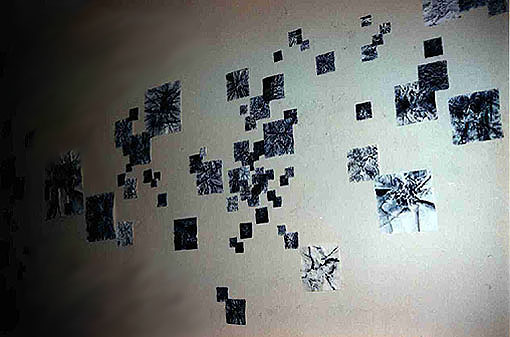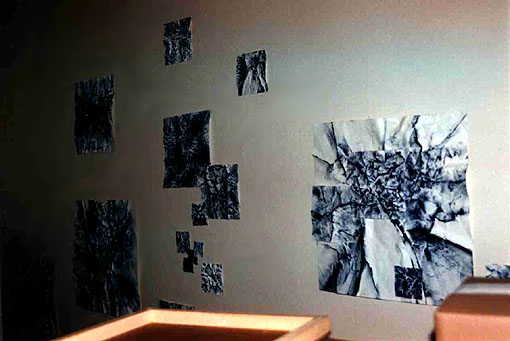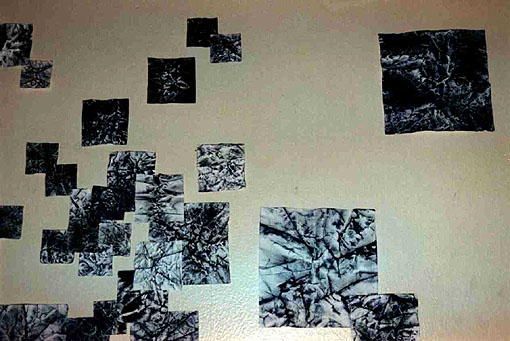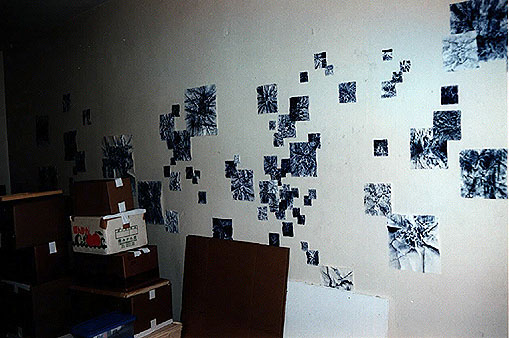neuronet (1993,1995-96)




* This essay was mainly written in 1995-96. I slightly changed some
parts at this time. 1999.
I often think, when we creat a work of art, we can creat a kind of information.
But, the meanig of a work of art is created by people who watch the work
of art. We can challenge to creat a work of art as metaphor. But, a work
of art always has differences. And, I think, it is not only the purpose
of art to creat meanings.
However, I try to talk about what I was thinking, when I was creating this
work. Please read this as a casual essey around this work. Mainly, I thought
around this work from the following subjects.
1 Rhizome of Deleuze Guattari
2 technology
3 hard cores of modernism
4 east and west
5 John Cage, Dada, Ryuichi Sakamoto
6 time , possibility
7 rich and poor
8 others
Rhizome of Deleuze Guattari
Rhizome is a kind of concept of Gilles Deleuze/Felix Guattari and the first
chapter of their book, Mille Plateaux.
In 1980's, I knew about Rhizome from a conversation of Japanese intellegents
like Akira Asada in a book. Rhizome seemed to be a kind of new keyword among
people in contemporary thought circle. So, I tryed to check the word, Rhizome.
And, I simply understood the following at that time. Rhizome is a kind of
concept to go beyond dualism, too much distinguished system and to recover
dynamism about not only contemporay society but also various matters. Rhizome
is not like a tree which spread from only one point. But, it is not just
diversity which has no starting points. Rhizome is free to connect and disconnect
anywhere.
Around 1994, I found a Japanese translation of Mille Plateaux. Especially,
I did not look for it.
The first chapter, Rhizome was like a literature or poetry. So, I understood
it very abstractly. Actually, it is hard to understand their book perfectly
and we need a lot of intellectual background to understand their book.
At the almost same time, I started my work, neuronet. After that, I stopped
to creat neuronet for a while. And, I restarted in 1995.
Anyway, when I was creating this work, I recalled some phrases of Rhizome
and compared my work with some phrases of Rhizome.
a copy but a map, but a map already has a quality of a copy. to avoid creating
a copy, but creat a map through copying., escaping lines and intensity,
mechanical arrangement, body without organ, Pop analysis, nomadology against
settler's history, nevous system, a stuff which naturally change its quality
with increasing numbers of cutting and connecting, a stuff which always
have a lot of entrances, a stuff which have no beginning and no ending and
accelerate at the center...
I was thinking like those phrases. But, if we pick up and simplify one other
text or poetry too much, we lose or change the original meaning of the text.
So, I want to stop talking about it onece. Anyway, I was thinking about
various things like this, while I was creating my work.
technology
Around 1993-4, I heard about an internet. And, I thought an internet could
become like Rhizome. Deleuze/Guattari's concept, rhizome is about contemporary
society and capitalism. And, an internet is covering the world like Rhizome
and creating a lot of chances. And also, the Cold War was end around the
end of 80's. Euro also has some similarities. Deleuze/Guattari wrote Rhizome
before those events. But, on the other hand, we always need critical views
in some extend. It is like there was reality before everything happened.
There is a meaning which they wrote it before everything.
While I was creating my work, I wondered about images of internet and computer
graphics. Although my work is hand-made, the creative process is rather
digital. I created 2, 3, 4, ....36 inches squares. And also, I feel, this
is some kind of geographical photos from a satellite. And, some of them
have soft and organic feeling. Some of them are a little sharp and hard
like ice.
And also, I recalled a story about a natural drawing line and computer graphics.
Maybe, about 15 or 20 years ago, we could not creat complicated shapes like
plants, animals and Spielberg's dinasaur by computer graphics. After an
inovation of a geometric equation, it became possible. And then, a scientist
tryed to watch a natural drawing line by a microscope using the latest technology
that includes computer graphics. As the result, a natural drawing line separated
irregularly and could be expanded almost infinitely.
This is a story about the field that we can not make sure exactly with our
naked eyes. But, I think, we are watching it unconsciously.
But, in the field of the latest computer science, a computer which can infinitely
generate irregularity has already appeared. A program exists, if we put
it off, we can not recreat it anymore.
Theoretically, differences between a natural material and an artificial
material became ambiguous.
But, it is a different story that we are saving a lot of artificial materials
as garbages. And, we can not return them to nature. It is a serious enviromental
issue.
And also, according to works of art that we can look at, even though a computer
can generate irregularity infinetely. After all, If we look them through
a moniter or printer. We need to depend on the capacity of a moniter or
a printer. This is also a different issue.
hard cores of modernism
While I was creating this work, I bought a Japanese book, " Hard core
of Modernism-Critical Space." The book was about abstract expression,
formalism, minimalism and conceptualism. Some Japanese critics and artists
are discussing about them, mainly from art theories, like Clement Greenberg,
Michael Fried, Rosalind Krauss and so on. And, I could read their orignal
theories with Japnese translations.
When I was in Pratt, I read most of them in English in fine arts seminar.
But, I reviewed them again. And, I thought this work, neuronet was close
to modernism's stream.
Actually, if I did not know works of art after abstract expression, I should
not creat this work as a work of art.
Shortly, I want to talk about several important points of modernism in art,
which I thought at this time.
Greenberg's art theories start from Kant's self-critique. We can see one
simple stream that is reduction to essence of art. Abstract expression,
color field, minimalism, ( conceptualism ). Art has already seemed to reach
its essence of " 0 ".
But, I think, it is just one of important streams of art. ( I am not interested
in whether it is the most important, highest art or underground at this
time.)
And, we can think, it is Hegelic rather than Kantic to think about art history
as one big continuous stream. Kant denied to think history as one continuous
stream. For Kant, history is object itself which human beings never catch.
Kant also criticized human intellegence itself. Greenberg also said like
, " Avantgarde is effect not result." In a sense, Donald Judd
and some minimalists were lacking this kind of sense. But, as Greenberg
also stuck only painting, he might stick one historical convention. I think,
there is no which is right. And, personally, I do not want to deny Jadd's
way as one stream of modern arts.
According to human judgement and recognition, Kant distinguished three fields
like intellectual field, moral field and feeling.
A literary man, Souseki Natsume also distinguished F (knowledge, moral)
and f (feeling). He said that we can measure F and f as amount.
Kant referred to fandamental differences between logical recognition and
feeling. And, these two only synthesized by imagination. A critic, Karatani
is emphasizing a kind of spring in synthesizing by imagination.
I think this issue, a relation between logic and feeling is very difficult.
But, anyway, this issue already concerned a relation between a work of art
and viwers. And also, medium specific or conceptualism( medium as conveyor
of concept ).
In a sense, after abstract expression until minimalism, modernism in art
had rejected about existence of viewers. They denied differences by subjectivity
of viewers and sought objectivity.
But, conceptualists like Joseph Kosouth introduced differences by viewers
with referring to Wettegenstein's thought. There is a clear border between
minimalism and conceptualism.
Personally, although I did not have much knowlege of modernism's stream
after Greenberg. I had known Eizenstein's montage theory( a theory about
film ), I have kept thinking for a long time like existence or meanings
of a work of art will change by each viewer's capacity of knowlege, sensibility
and social, cultural background. There are differences around a work of
art. Even though the same work of art, I feel differences between at the
first time and when the time passed. But, we should reduced art to easy
subjectivity of viewers perfectly. And, the essence of art should not be
reduced to human relationship in art circles perfectly. In the sense, I
think, it is important that the critical approach of modern art and works
like Judd's in art history.
I want to talk around this work, neuronet.
I feel, my work seems to be most close to minimalism. And also, I can see
as a kind of mass of abstract paintings or a conveyer of some concepts.
Michael Fried rejected minimal arts and Donald Judd in 1960's. It was because
those works can not be clearly distinguished painting from sculpture. Actually,
Judd tended to go beyond dualism between 2-dimentionality and 3-dimentionality.
Fried called " theatrical " those works whose media can not be
clearly distinguished. And, Fried insisted that art should be " medium
specific."
But, in a discussion in 1987, Fried talked like, " We might be able
to expand or lose a notion of medium," with referring to the works
of Laurie Anderson.
According to my work, I repeated to crash, spread and paint hundreds rectangle
papers. I feel my work is not clear, painting or sculpture. And also, there
are a lot of lines on my work. My work also seems to be a kind of drawing.
And also, if I think about my creating process, my work seems to be a kind
of strange printmaking.
Michael Fried's rejection against theatricality might have come from Greenberg's
self-limitation. But, there are many differences between Fried and Greenberg's
opinions.
And, not only self-limitation and reduction, modernism's stream included
various important issues about art and visual.
For example, a relation between figure and ground, a relation between a
sense of visual and a sense of touch, antholopomolphism( issues about a
body and so on).
According to a relation between figure and ground, I thought a similarity
between my work and Julian Schnabel's saucers' painting. And, maybe, my
work's look will change from a distance or close.
And also, I thought about an issue whether a rectangle is neutral or not.
To be sure, not only a painting but also a photograph and a movie screen
are rectangle. But, I think a rectangle is a shape which we do not have
to care the existance of frames most rather than neutral. And, I think,
we never reach true neutrality or objectivity. We need to keep escaping
from objectivity that we thought. I think, there is no way except that.
Although I shortly reviewed about modernism in art, huge discussions should
have been taken place by many artists and critics. I guess, it was a rich
and intellectual period for art. And, I think, it is still possible to creat
and talk around several cores of modernism.
In a large sense, to talk like this is a part of self-critique in modernism's
stream. I can not have interest in an issue about modernism or postmodernism
so much.
And, at this time, I put my work on the wall directly. But, I also do not
care an issue about site specific or site generate so much. As it is tough
to bring my work, I am planning to creat some versions on boards something.
A director of Documenta 9, Jan Hoet talked about two poles once. One is
by Donald Judd. Another one is by Joseph Beuys. Judd is a pole of objectivity.
Beuys is a pole of subjectivity. And, many artists are still doing dialogue
with these two artists.
In a sense, I think my work is also a dialogue with Donald Judd.
But, according to my motivation and action to creat this work, I am close
to Joseph Bueys.
Beuys was interested in the world of dynamism inside object rather than
object itself. He saw everything as a flow of energy with including human
individuals.
But, not only Joseph Bueys, I think, each artist talked in modernism's stream
also might have creat works with individual reality. For instance, Mondorian
was involved in theosophy.
After Greenberginism, modernism's reduction process tended to be formalistic
and materialistic. But, if we think about Platonism or Spiritualism, we
need to think about art as a totally different thing.
east and west
Exactly, art is one part of human culture. But, after abstract expression
until minimalism, modernism in art went foward with eliminating cultural
issues. Only medium was left. It makes sense, because every cultural issue
is subjective.
Therefore, in a sense, we can say, Joseph Kosouth's position, an artist
as antholopologist is a reactionary position.
However, realistically, I think that most people watch works of art through
cultural color glasses.
For example, before I knew about main theories of modern arts, I was thinking
like," Simplicity of Judd's work and Japanese architecture have something
common in."
For the eyes of outsider of art, works of art are reflected like this, aren't
they ?
I like to watch works of art in chaos rather than with following rules in
an art history textbook.
While I was creating my work, I also thought various things from cultural
views.
I have already talked, my work is close to minimalism or abstract arts.
Although modernism is not cultural, it belongs to American or Western culture.
But, my work also has a lot of Eastern cultural tastes. I thought, my work
looked like Sho-ji screen in Japanese interior. And also, shibori textile.
And also, my work looked like oriental hand-made paper, etc.
I often think about traditon. It might be because, I often go to a museum.
A museum is the place which open to the door to history.
I really like to watch works of antient art like Roman, Greek, Egypt, etc.
And also, I like an old Japanese architecture in Kyoto. But, I watch them
totally as the past works of art, because they came out from realities in
each time. And, I think, a work of art can not completely cut from daily
life, although it is not equal to noisy and kitsch reality. In a sense,
an artist is a prisoner of the times.
People have different opinions about what we should take over from the past
as tradition. We can not make a copy and a stuff which completely cut from
a flow of time. What is art of our times ?
And, modern nationalism tend to distinguish art in each country. But, exactly,
it is impossible to reduce a work of art to one country. Every work of art
has its own geography.
John Cage, Dada and Ryuich Sakamoto
While I was creating this work, I also thought about John Cage's mashroom
art.
Donald Judd's work has very heavy feeling. It seems to represent certainty.
But, my work is like floating spores. Lightness. Natural growth. It is also
information rounding on electric circuit.
Accident was important for Cage. Dadaists also.
I crushed papers by my hand. I tryed to creat or control accidents consciously.
And, I tryed to control my work by my hand, but accidents were coming out
through my fingures. I was thinking something like that.
John Cage did a concert that played the same music of Eric Satie 840 times.
Most people did not appear, because they thought that they knew what would
happen. Cage and some pianists also expected that it would be just repetition.
But, after 18 hours, Cage and pianists were really suprised at the result.
It was because they were awaking to find no the same playing. And then,
they noticed their lives totally changed at that time.
At the almost same time, Andy Warhol was also creating films like just eating
and kissing.
While I was creating this work, I was recalling these episodes. And, I thought,
I wanted to experience something through creating this work. Frankly, I
am not sure it. But, I think, I got something. And also, I wanted to get
some intensity to my work.
Gilles Deleuze might refer to this issue in his book, " difference
and repetition," although I have not read it carefully yet.
A musician, Ryuich Sakamoto composed a music like John Cage by electric
instrument. Actually, I often listen to his music rather than John Cage.
I happen to think of this work's title from a part of his song.
time, possibility
While I was creating this work, I felt it was showing a kind of time. It
was like a moment which many rectangles are coming out and floating. And
also, a moment of collapsing something. A moment including possibilities.
And, I recalled " presence " that Michael Fried emphasized. He
rejects to experience a work with spending for a long time like theater
or film. It is important for Fried to experience a work of art in a moment
which reach eternity. A moment including differences. Experience of timelessness.
I a little thought about Arthur Rimbaud's passage.
" I found out !
What ? Eternity.
the ocean melting into the sun..."
(doutful translation from Japanese translation version)
And also, A play writer, Hideki Noda's passage.
" the fastest landscape in the world is always stopping.
And, nobody is breathing there."
Deleuze-Guattari also
" You should be fast, even though you don't move there."
Although I feel, this is different a little bit, Ryuich Sakamoto was talking
like
" I am interested in a situation which keeps sounding."
Anyway, a moment including differences or experience of timelessness. It
sounds good and attractive.
But, I think, it is only a story in our imagination or mysticism.
And, Fried's opinion clearly includes a relation between a work of art and
viewers. Fried is very different from Greenberg at this point.
If I do not feel anything from a work of art in a moment, I might not watch
it. But, personally, I like to think and imagine various things from a work
of art with spending long time and walking around. Especially, when I look
at an installation.
And, even though I feel my work is floating, realistically, my work is stopping.
Even though my work seems to show something differences, my work is not
anything except my work. It is impossible to creat a work of art including
differences in a space of reality.
However, an artist, Kenjiro Okazaki says, we have some situations to need
perception like Michael Fried in contemporary society.
For example, when we think about enviromental problems. It is difficult
for us to perceive enviromental problems in our daily life. But, they already
exist as cracks in the present.
If we understand those conflicts in time and space, they always come out
as a prediction. It is like present conflicts are signs. The end will come
in the future.
And also, if we think like peace after war, peace after war in a continuity
of time, history will repeat. We need to ensure present conflicts. As we
can not ensure conflicts, we request the end. Sense of timelessness.
And, although this is different a little bit, I recalled an episode.
In 1946, Sartre published a book. But, there was anything about the Holocaust
in the book. It was because the Holocaust was the event which nobody could
know the whole of the event in those days.
I think, this is the same about any slaughter like Japan did in Asia.
Anyway, according to my work, I hope people feel various possibilities,
they are not only dark things, but also something fun.
rich and poor
While I was creating my work, I also thought whether my work is rich or
poor.
And also, when I go to museum, I often think about the same issue. And also,
what is universal in art.
Some people might tend to reach the easiest conclusion. It is like sophisticated
and high-technique work is universal.
But, it is not everything. And, it is not only the essence of art. And,
I think that art is not always rich. It is like not only rich people are
living in the world. In contemporary art, there is already a field, "
Arte Povera ". And also, I think, art is not always equal to beauty,
especially contemporary art. I think, it is the same about literature, theater
or music.
I think that it is important to keep counterpoints like x, -x, 1/x, 1/-x
: rich, poor, showly, simple, something like that in order to avoid the
easiest conclusion.
But, actually, anything never be clear, even if we think about counterpoints.
others
According to color, as I imagined about the blue earth first, I used blue.
And, I also thought the blue of computer moniter.
But, especially, there is no meaning about color at this time. If I have
a chance, I also want to creat some other color versions.
Anyway, I talked a lot of things around my work. Some people might think
and feel totally different things.
And, basically, I think that my work can be cut from my talking.
But, I do not think that I talked about what totally had nothing to do with
my work.